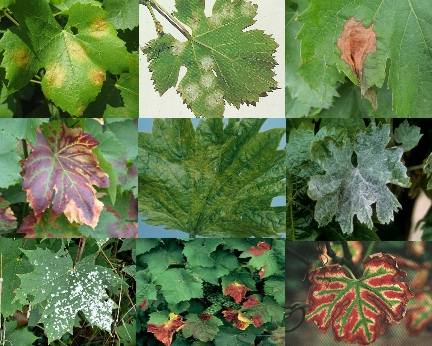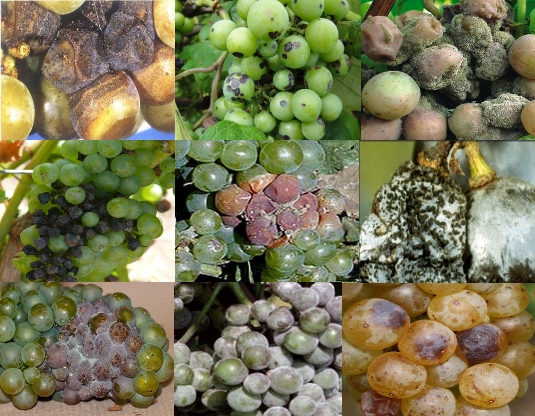| There are many types of fungi that can cause disease in the grape plant. Some fungi affect first and foremost the grapes, others the leaves and still others the wood. But usually they can infect all parts of the plant. |
 Some foliar symptoms |
| Most fungi need a porte d’entree. Often these are damages caused by pruning, by hailstorms, by attacks fdrom bugs and so on, but sometimes also simply because the plant is already weakened for example by insufficient nutrition. |
| The fungi that affect grapes are often called ‘rot’: bitter rot, black rot, grey rot and so on. Anthracnose is a term often used in French. Anthracnose is a Greek word of origin and means charcoal (anthrax) disease (nosis). The French tend to call all bunch-rot diseases anthracnose, while in other countries the name anthracnose is reserved for the disease caused specifically by the fungus Elsinoë ampelina. |
 Some of the fruit symptoms |
| Fungi affecting leaves are downy and powdery mildew, as well as sooty mould and redfire. In French: mildiou, oïdeum, fumagine and rougeot. |
| Diseases affecting wood used to be often called ‘dead arm’ or ‘black dead arm’. Although these names are still used, it is now common to call these diseases Grapevine trunk disease or Bot canker or also Grapevine decline syndrome. There are many types of fungi that can lead to this disease. If one of the Botryosphaeria fungi is the cause, it is also called Botryosphaeria canker. ‘Dieback’ is a name for branches that begin to die off at the tip, with the process advancing further and further towards the trunk. Some examples are Esca, Eutypiosis and Diplodia cane dieback. |
| Actually, the names dead arm, black dead arm and dying arm are obsolete, but they are still widely used. |
 Some symptoms of the wood |
| Another common name is Excoriosis. Literally, it means moulting and indicates damage on the branches. It used to be thought that this disease was caused by Phomopsis viticola and also led to black dead arm. Today, we know that they are two different diseases with two different causative agents: the Bot canker caused by Botryosphaeria dothida and the Phomopsis cane blight caused by Phomopsis viticola. |
| The use of names of diseases and pathogens is not yet very well regulated internationally, as the examples described above show. There are a number of logical reasons for this: many diseases are very similar, in many diseases several different fungi can be found, and new fungal species are still being discovered. Also, some diseases can be caused by one and the same fungus such as Botryosphaeria dothidea that can lead to both Macrophoma rot and dieback disease. |
| French name | English name | pathogen | synonyms | characteristic diseased part | main characteristics | status |
|---|---|---|---|---|---|---|
| Fumagine | sooty mold | fungus growing on excrement of lice | leaf | Black sticky layer on blades | ||
| Rougeot parasitaire; le brenner | angular leaf scorch | Pseudopeziza tracheiphila; Pseudopezicula tetraspora | leaf | red spots on leaf | ||
| Mildiou | downey mildew | Plasmospora viticola | Peronospera | leaf | Top leaf yellow oily spots, bottom leaf grey fungal fluff; grey fungal fluff on grapes | Very frequent and high damage |
| Oïdium | powdery mildew | Uncinula necator; Erysiphe necator | Oïdium Tuckerii | leaf | white mould fluff | Very frequent |
| Esca (mild form, leaf form); esca means fungus | black measels | Phaeoacremonium aleophilum; Phaeomoniella chlamydospora; Fomitiporia mediterranea | leaf, grape | leaves get blue marble-like spots; branch dies off | infrequent | |
| Verticilliose | Verticillium dahliae; Verticillium albo-atrum | leaf | mild form: yellowish or reddish spots sometimes with necrotic centre; flowers or fruits are desiccated; severe form: apoplexy of the branches | |||
| Coître; rot blanc; maladie de la grêleCoître; rot blanc; maladie de la grêle | hail disease; livid rot; white rot | Guignardia diplodiella, Coniothyrium diplodiella | Conielle diplodiella | leaf, stems | young shoot tips turn yellowish; berries develop pustules that turn brown and cause the berry to dry out; often occurs after hailstorms | widespread |
| Phomopsis cane blight and leaf spot (still incorrectly called excoriosis in France) | cane blight and leaf spot, cane spot; fruit rot disease; vroegere naam: dead arm | Phomopsis viticola | Sphaeropsis viticola; Diaporthe viticola | leaf, stems and wood | spots on leaves and lesions on shoots and branches; lesions can fuse and cause cracks to form. | widespread; leads to limited damage. |
| Pourriture grise (moisissure grise) | grey mould disease; Botrytis bunch rot (and blight); grey mold (Am.) | Botrytis Cinerea; Botryotinia fuckeliana | grape | spots on leaves and lesions on shoots and branches; lesions can fuse and cause cracks to form. | frequent; much damage | |
| Pourriture noirPourriture noir | black rot | Guignardia bidwelii | Botryosphaeria bidwellii | grape | Fruit wrinkles and turns black, falls off; all green tissues also become diseased | frequent; much damage |
| Anthracnose | bitter rot | Greeneria uvicola | Melanconium fuligineum (verouderd) | grape | gives bitter taste to grapes; especially the ripening fruit will rot, not the unripe fruit; tendrils, stems and leaves also get sick. | not in France |
| Ripe rot | Glomerella cingulata; Botryosphaeria ribis | Colletotrichum gloeosporioides | grape | attacks ripening fruits and covers them with salmon-coloured to pink spores; sometimes the grapes fall off. | probably not in France | |
| macrophoma rot | Botryosphaeria dothidea | grape | dark spots on grapes leading to watery rot; fewer spots than ripe rot and sour rot; skin of grape releases easily | |||
| Anthracnose (in the narrow sense) | birds eye; black spot | Elsinoë ampelina | Gloeosporium ampelophagum; | grape | Shoots and grapes get spots and grapes remain sour; bird's eye on grapes; shoots, petioles and leaves are also affected | not common |
| Pourriture acide | sour rot; sour bunch rot | various fungi, including Alternaria, Aspegillus, Cladosporium, Rhizopus, Penicillium, some yeasts and the bacterium Acetobacter. | grape | Soft watery rot of grapes with vinegar smell | ||
| Esca ‘apoplexy’, wood form; (Esca means fungus) | Esca "apoplexie" | Phaeoacremonium aleophilum; Phaeomoniella chlamydospora; Fomitiporia mediterranea | wood | branch dies quickly | infrequent | |
| Eutypiose | Eutypa dieback; dying arm disease; dead arm disease | Eutypa lata | Eutypa armeniacae | wood | Side branches die off | infrequent |
| Chancres à Botryosphaeria, Diplodia, Excoriosis (obsolete name) | Grapevine trunk disease; Diplodia cane dieback; bunch rot, excoriose (verouderd), black dead arm | Botryosphaeria australis, B. dothidea, B. lutea, B. obtusa, B. parva, B. rhodina, B. sarmentorum, B. stevensii and B. viticola | Diplodia (telemorf); Neofusicoccum parvum | wood | Small black spots on young branches; branches growing together; fading on young branches; on leaf small bright green spots sometimes with necrotic centre; severely affected leaves may fall. Fruit may sometimes wilt; necrotic wedge forms in wood causing side branches to die | |
| Fusariose | Fusarium | wood | Rotten wood overgrown with white to whitish-pink fungal flakes | not in France | ||
| Maladie du pied noir; gangrène | Black-foot disease | Cylindrocarpon liriodendri (=anamorph); Fomitiporia mediterranea; Phaeomoniella chlamydospora; Phaeoacremonium aleophilum; cylindrocarpon macrodidynum; cylindrocarpon destructans | Ilyonectria liriodendri; Neonectria liriodendri | wood | Weakens the plant and leads to death; Brown-black necrosis on the graft; Budding fails to occur or weak leaf growth; Roots do not grow deep or parallel to the soil; Often a second level of roots develops, allowing the plant to live a short period longer. | |
| Pourridié | oak rot fungus | Armillaria mellia | wood | Schors valt uit elkaar; zwammen aan de basis van de plant ter hoogte van entstam |

Comments
Fungal Diseases — No Comments
HTML tags allowed in your comment: <a href="" title=""> <abbr title=""> <acronym title=""> <b> <blockquote cite=""> <cite> <code> <del datetime=""> <em> <i> <q cite=""> <s> <strike> <strong>